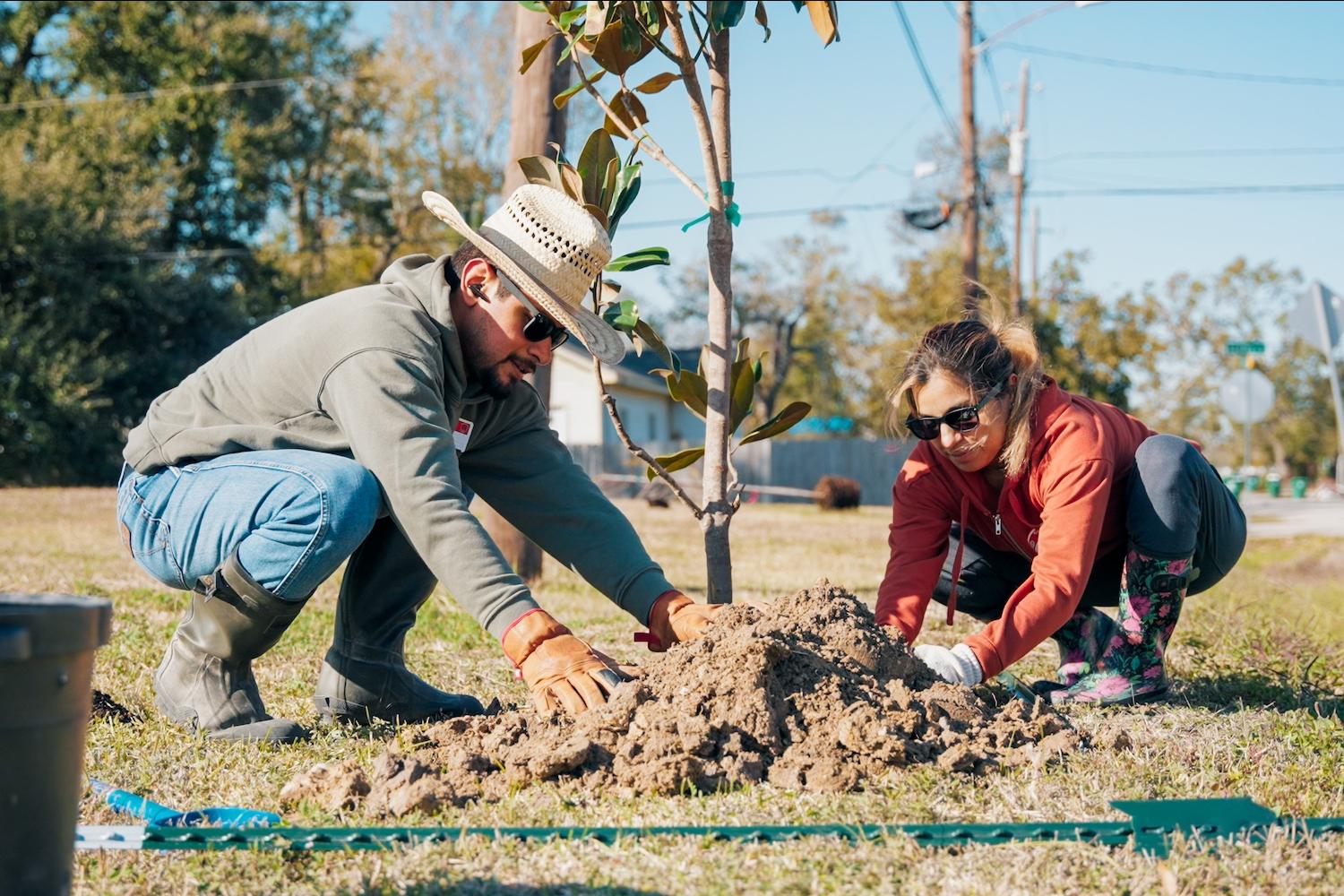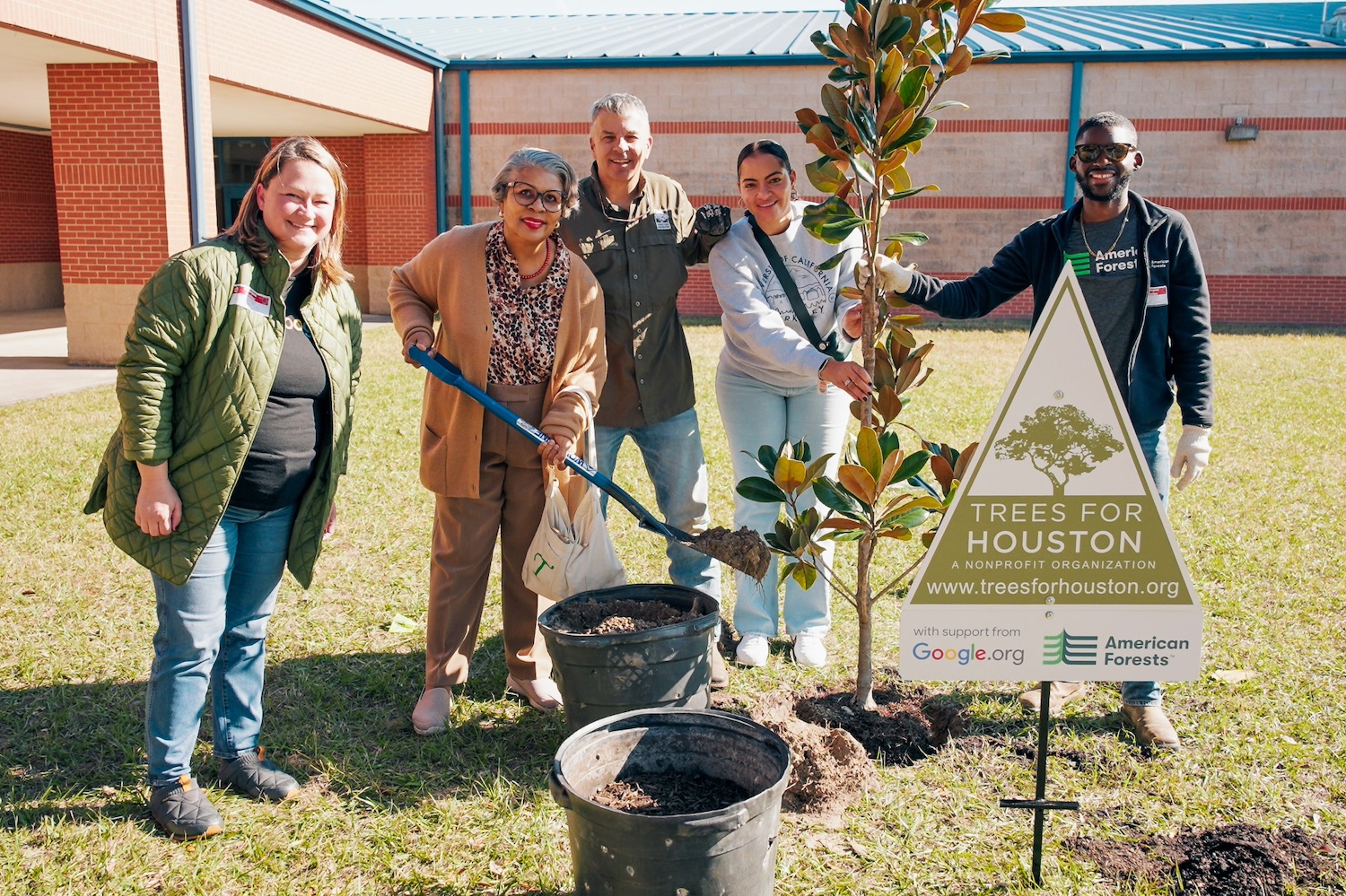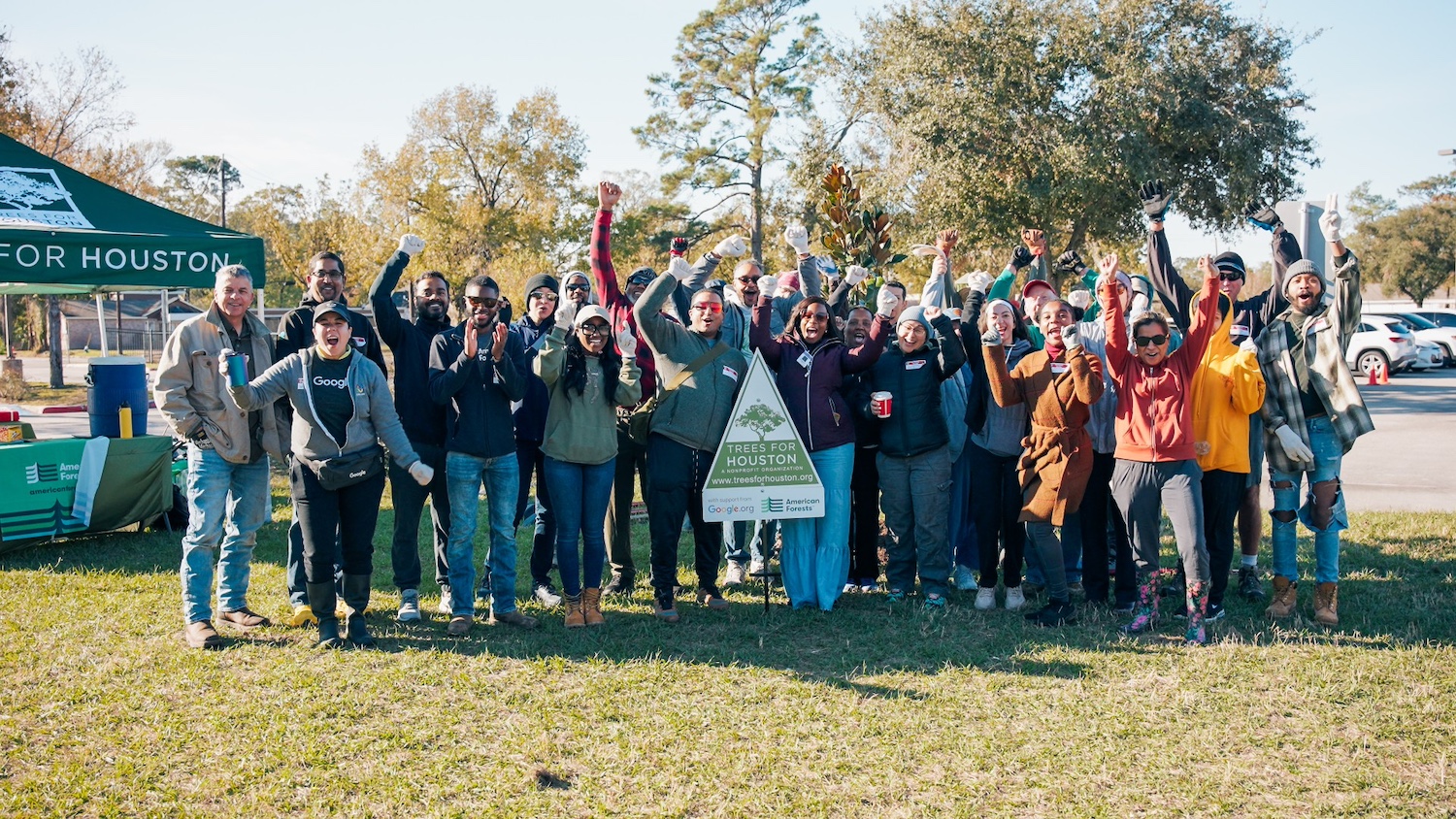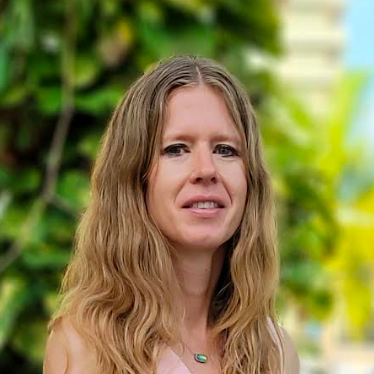
Volunteers plant trees at Shadydale Elementary School in Houston during the launch of the Tree Equity Score Analyzer. (Image: Thomas Koenig, Big Pineapple Productions.)
Mythology imbued trees with special powers — healing and protecting against evil spirits, transmitting knowledge and magical properties, symbolizing immortality or omens of doom. Supernatural or not, focusing on the preeminence of trees was spot-on. Trees have an outsized impact on our communities — cooling our cities, saving us money and bolstering our health. Yet, not everyone has access to these life-giving plants. Communities of color in the United States have 38 percent less tree cover than predominately white communities. And the extent of leafy canopy in lower-income neighborhoods is over a fourth lower compared to wealthier ones.
Houston — a Texas city with only 18 percent tree cover — has a chance to address this inequality. As one of the U.S. cities with the most intense urban heat islands, Houston aims to plant 4.6 million trees by 2030. Thankfully, there’s a new tool at its disposal: the Houston Tree Equity Score Analyzer. By providing detailed data on tree cover, this platform from American Forests aids urban forestry efforts, prioritizes neighborhoods and estimates the benefits of planting trees. It’s a chance for Houston to go green where it needs it most.

Addressing tree inequity
The newly launched Houston Tree Equity Score Analyzer is an offshoot of American Forests’ Tree Equity Score, which maps tree cover in 2,600 urban areas across the U.S. It is a free application developed in partnership with Google.org, Trees for Houston, the local government, environmental groups and residents. Compared to the nationwide platform, the Houston analyzer provides additional tools and insights for planting, setting targets and tracking progress.
In addition to tree canopy coverage, the platform also maps building density, demographics, and other indicators by neighborhood. The overall score given to an area estimates the potential for tree cover and the need for it according to heat severity, income levels, health, employment and other factors.
“To me, tree equity is the acknowledgment that everyone deserves access to trees, to the life-saving, life-sustaining benefits of trees,” said Chris David, vice president of geographic information systems and data science at American Forests. “And creating healthy, heat resilient communities.”
Many communities lack adequate tree cover, often stemming from racist practices like redlining, David said. For instance, formerly redlined communities have 23 percent fewer trees than those that were not.
Wealthier neighborhoods benefit from another advantage, too. “They also have more time to advocate to their local representation for investment in their communities,” David said. “Those communities, to this day, get more investment from the city than those lower-income communities that really need it the most.”
The tree equity score is a chance to level the playing field of foliage.
“What the tree equity score is really good at is taking a lot of information, combining it, and making it simple to share back out into the world,” David said. “So a tree equity of 70 is telling you something. It's telling you we need trees. We need a fair amount of trees in this neighborhood to get to what we call, ‘tree equity.’ Tree equity means you have a score of 100.”
Texas tree equity
Houston has a composite tree equity score of 90 but varies from the low 60s to 100 across neighborhoods. Plus, 73 percent of its residents experience increases of 8 degrees Fahrenheit or more from the heat island effect.
“It's a city that, in particular, feels the impacts of a changing climate through the increasing number of extreme heat days,” David said. “But it's also near the coast and is impacted by severe coastal storms.”
Despite its ambitious tree-planting goals, Houston has lost ground. In the decade prior to 2021, Harris County, where Houston resides, lost nearly 10 percent of its tree cover.
But the Houston Tree Equity Score Analyzer provides planning support to help tackle that problem. For instance, it calculates the benefits of existing and increased tree cover — including the total economic value, carbon capture and reduced air pollution — while also determining the number of trees needed to hit various goals for each neighborhood.
American Forests recently improved the tool, adding data on households with limited English-speaking ability, which is a driver of inequity, David said. The organization is also launching a Spanish-language version in June.
Houston isn’t the only metro area to benefit. The Tree Equity Score Analyzer was tailored for other cities like Detroit, Washington D.C. and Boston. And it’s helping these areas with their urban forestry efforts. For example, Phoenix incorporated tree equity scores into its shade master plan in 2024, David said.

The need for trees
Given the plentiful benefits trees shower on urbanites, all this effort is worth it.
“It's quite amazing, in the age of climate change, to think about trees because, to me, they are nature's perfect technology to fight climate change,” David said. “They sequester carbon, they filter air pollutants and they reduce energy costs, which are increasing with climate change. And they mitigate the increasing and exacerbating impacts of extreme heat and other climate impacts on existing conditions like asthma and heart disease.”
Trees are well-known for fighting the urban heat island effect, a phenomenon that occurs when urban areas become hotter because built infrastructure is absorbing and emitting heat from the sun. On average, heat islands can be up to 7 degrees Fahrenheit hotter than surrounding areas. These sizzling-hot urban environments can exacerbate heat waves, increasing the risk of illness and even death. And that heat is not evenly distributed.
“Lower-income communities tend to have, on average, about 26 percent less tree cover and are also almost 6 degrees hotter in the summer than wealthier ones — and even more so in communities of color,” David said. “That's regardless of income.”
Plus, these areas may already be at a disadvantage.
There’s a link between lower-income communities and people with pre-existing health conditions, like diabetes or cardiovascular disease, that put them at greater risk during heat waves, David said. Children and the elderly also face a higher likelihood of illness and death from heat. Put together, this can be a deadly combination.
“There are lots of studies out there about the increase in mortality related to extreme heat, and one coming out of Duke University found that it's an increase of almost ninefold to about 100,000 people annually in the next decade of heat-related deaths,” David said. “That affects mostly lower-income communities, communities of color, and often those are people living in homes with inadequate cooling.”
Trees are an effective way to chill scorching cities. On average, urban forests can be up to 3 degrees Fahrenheit cooler than non-green areas. Parks and gardens have a cooling effect over three-fourths of a mile away.
Besides protecting us from heat, trees improve our health in other ways like reducing stress, improving mood and attention, and boosting our immune systems. Urban forests also encourage physical activity and can lower cardiovascular disease risk.
Plus, a tree-filled neighborhood improves property values and is linked to reduced crime rates. And tree planting can create jobs in lower-income communities, David said.
Nearly 80 percent of urban neighborhoods in the U.S. lack adequate tree cover. Achieving tree equity would provide $3 billion in benefits annually.
“We need about 500 million additional healthy trees in order to achieve what we call ‘tree equity,’” David said. “That's a huge, huge undertaking that's going to require big investment from all levels of governance, from individuals to foundations. But we're going to have to chip away at it one step at a time in order to do that.”
That’s a big task, but it’s ultimately worth it. Tools like the Houston Tree Equity Score Analyzer can help us get there — one seedling at a time.

Ruscena Wiederholt is a science writer based in South Florida with a background in biology and ecology. She regularly writes pieces on climate change, sustainability and the environment. When not glued to her laptop, she likes traveling, dancing and doing anything outdoors.














